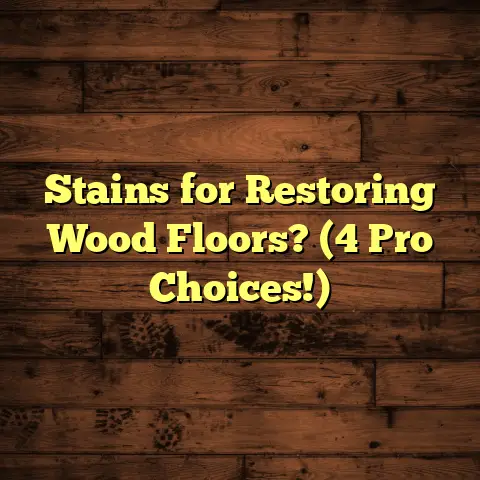Floor Scratch Prevention Tips? (1 Trick Installers Use!)
Imagine this: You’re home after a long day, the scent of your favorite candle is in the air, and the evening light streams through your windows.
You walk across your beautiful hardwood floor, noticing the way it gleams. It’s smooth, inviting, and scratch-free.
But then, a memory hits you – last week, you saw a new scratch that marred the surface.
It’s a disheartening moment, right? How can we prevent these scratches from ruining our floors?
In this guide, I’ll share floor scratch prevention tips to keep your flooring looking immaculate.
I’ll also reveal the one trick that professional installers, like myself, swear by for flawless surfaces. Let’s dive in!
1. Introduction to Floor Scratch Issues
The Emotional Impact of Scratches on Flooring
Let’s be real: scratches on your floor are more than just cosmetic issues. They can be downright frustrating.
A pristine floor adds value and beauty to your home. Scratches can make a space feel worn and neglected.
Think about it, a flawless floor is a point of pride. Scratches chip away at that feeling.
Common Causes of Scratches
What causes these pesky scratches? Here are a few culprits:
- Pets: Their nails can do a number on your floors.
- Furniture: Moving furniture without protection is a scratch waiting to happen.
- High Foot Traffic: Dirt and grit tracked in on shoes act like sandpaper.
- Environmental Factors: Dust and debris can also contribute to surface damage.
The Importance of Prevention Over Repair
Repairing scratches can be costly and time-consuming.
Preventing them in the first place is the smarter move. It saves you money and keeps your floors looking great longer.
As the saying goes, an ounce of prevention is worth a pound of cure.
2. Understanding Different Flooring Types
Overview of Popular Flooring Materials
Let’s talk flooring. Here are some popular types:
- Hardwood: Classic, beautiful, but prone to scratches.
- Laminate: More scratch-resistant than hardwood but can still be damaged.
- Tile: Durable and scratch-resistant, but grout can be a pain.
- Vinyl: Affordable and water-resistant, but vulnerable to cuts and dents.
How Each Type Reacts to Scratches and Wear
Each flooring type reacts differently to wear and tear.
Hardwood shows scratches more easily than tile. Laminate can chip if not properly cared for.
Vinyl can tear, while tile can crack under heavy impact.
The Significance of Knowing Your Flooring Type
Knowing your flooring type is crucial for effective care.
What works for hardwood might not work for vinyl. Understanding the vulnerabilities of your floor helps you protect it better.
For instance, you wouldn’t use the same cleaning products on hardwood as you would on tile.
3. Everyday Tips for Scratch Prevention
Utilizing Area Rugs and Mats Strategically
Area rugs and mats are your first line of defense.
Place them in high-traffic areas like entryways, hallways, and in front of sofas.
They not only add style but also protect your floors from dirt and scratches.
I always recommend using rugs with non-slip pads underneath to prevent them from sliding.
The Importance of Furniture Pads
Furniture pads are a must. Stick them under the legs of all your furniture.
They create a barrier between the furniture and the floor, preventing scratches when you move things around.
Make sure to check and replace them regularly, as they can wear out over time.
Regular Cleaning Routines
Regular cleaning is essential. Dirt and grit act like sandpaper, scratching your floors with every step.
Sweep or vacuum regularly to remove debris. Use a microfiber mop for damp mopping.
Avoid harsh chemicals that can damage the finish of your floors.
Encouraging a No-Shoe Policy
A no-shoe policy can make a huge difference. Shoes track in all sorts of dirt and grime.
Encourage family members and guests to remove their shoes at the door.
Provide a shoe rack or basket to make it easy for them.
4. The One Trick Installers Use
Introduction to the Trick: Applying a Protective Sealant
Here it is, the one trick installers use: applying a protective sealant.
A sealant creates a barrier that protects your floors from scratches, stains, and wear.
It’s like giving your floors a shield against everyday damage.
Explanation of Different Types of Sealants and Coatings Available
There are several types of sealants and coatings available:
- Polyurethane: Durable and long-lasting, ideal for hardwood.
- Acrylic: Affordable and easy to apply, good for vinyl and laminate.
- Wax: Provides a natural look, but requires more frequent application.
Each has its pros and cons, so choose one that suits your flooring type and lifestyle.
Step-by-Step Guide on How to Properly Apply a Sealant to Your Flooring
Here’s how to apply a sealant properly:
- Prepare the Floor: Clean the floor thoroughly, removing all dirt and debris.
- Sand Lightly: For hardwood, lightly sand the surface to create a better bond.
- Apply the Sealant: Use a foam brush or applicator pad to apply a thin, even coat.
- Let it Dry: Allow the sealant to dry completely, following the manufacturer’s instructions.
- Apply a Second Coat: Apply a second coat for added protection.
The Long-Term Benefits of Using This Trick
Applying a sealant offers long-term benefits:
- Scratch Resistance: Protects your floors from everyday scratches.
- Stain Resistance: Makes it easier to clean up spills and messes.
- Extended Lifespan: Helps your floors last longer by preventing wear and tear.
It’s a simple step that can save you a lot of headaches down the road.
5. Seasonal Care Tips
How Different Seasons Affect Flooring
Different seasons can impact your flooring.
Winter brings salt and moisture, while summer brings heat and humidity.
Winter Care: Managing Salt and Moisture
In winter, salt and moisture can damage your floors.
Use mats at entryways to trap salt. Wipe up spills immediately to prevent water damage.
Consider using a humidifier to maintain a consistent moisture level.
Summer Care: Dealing with Heat and Humidity
Summer heat and humidity can cause floors to expand and contract.
Use blinds or curtains to block direct sunlight. Maintain a consistent temperature with air conditioning.
Avoid excessive moisture by promptly cleaning up spills.
6. Long-Term Maintenance Strategies
Scheduling Professional Inspections and Refinishes
Schedule professional inspections and refinishes periodically.
A professional can identify potential problems early on and recommend the best course of action.
Refinishing can restore the beauty of your floors and extend their lifespan.
The Importance of Regular Maintenance
Regular maintenance is key to sustaining floor integrity.
Follow a consistent cleaning routine. Address minor issues promptly to prevent them from becoming major problems.
How to Spot Early Signs of Wear and Tear
Keep an eye out for early signs of wear and tear:
- Fading: Indicates sun damage or wear from foot traffic.
- Scratches: A sign of inadequate protection.
- Gaps: Can indicate moisture issues or improper installation.
Addressing these issues early can prevent costly repairs later on.
7. Conclusion
Recap of the Importance of Prevention
Preventing scratches is crucial for maintaining beautiful floors.
Simple steps like using rugs, furniture pads, and sealants can make a big difference.
Encouragement to Implement the Tips Discussed
I encourage you to implement these tips for a scratch-free flooring experience.
Your floors are an investment. Taking care of them will pay off in the long run.
By following these guidelines, you can keep your floors looking their best for years to come.





